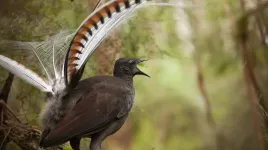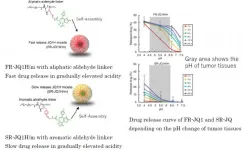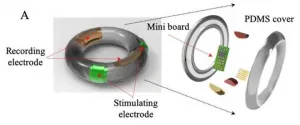Dinosaur species: 'Everyone's unique'
Paleontologists from the Universities of Bonn and Liverpool examined 14 skulls of Plateosaurus trossingensis
2021-02-26
(Press-News.org) "Everyone's unique" is a popular maxim. All people are equal, but there are of course individual differences. This was no different with dinosaurs. A study by researchers at the University of Bonn and the Dinosaur Museum Frick in Switzerland has now revealed that the variability of Plateosaurus trossingensis was much greater than previously assumed. The paleontologists examined a total of 14 complete skulls of this species, eight of which they described for the first time. The results have now been published in the scientific journal "Acta Palaeontologica Polonica".
Plateosaurus lived during the Late Triassic, about 217 to 201 million years ago. "With well over 100 skeletons, some of them completely preserved, it is one of the best known dinosaurs," says Dr. Jens Lallensack, who researched dinosaur biology at the University of Bonn and has been working at Liverpool John Moores University (UK) for several months. The herbivore had a small skull, a long neck and tail, powerful hind legs and strong grasping hands. The spectrum is considerable: Adult specimens ranged from a few to ten meters in length, weighing between about half a ton and four tons.
The first bones of Plateosaurus were found as early as 1834 near Nuremberg, making it the first dinosaur found in Germany, and one of the first ever. Between 1911 and 1938, excavations unearthed dozens of skeletons from dinosaur "graveyards" in Halberstadt (Saxony-Anhalt) and Trossingen (Baden-Württemberg). A third such cemetery was discovered in the 1960s in Frick, Switzerland. "It's the only one where there are still digs every year," Lallensack says. The material from Frick, which is described in detail for the first time, includes eight complete and seven fragmentary skulls excavated by Swiss paleontologist and dinosaur researcher Dr. Ben Pabst and his team.
Natural variation between individuals
Dinosaurs have been preserved for posterity mainly through bones. Paleontologists rely on anatomical details to distinguish different species. "A perpetual difficulty with this is that such anatomical differences can also occur within a species, as natural variation between individuals," Lallensack reports. Researchers at the University of Bonn and the Dinosaur Museum Frick (Switzerland) have now been able to show that Plateosaurus anatomy was significantly more variable than previously thought - and the validity of some species needs to be re-examined. These findings were made possible by analyses of 14 complete and additional incomplete skulls of Plateosaurus. "Such a large number of early dinosaurs is unique," says paleontologist Prof. Dr. Martin Sander of the University of Bonn.
Can all these fossils from Germany and Switzerland really be assigned to a single species? Answering this question has become all the more urgent since Martin Sander and Nicole Klein of the University of Bonn published in "Science" in 2005. According to this, Plateosaurus was probably already warm-blooded like today's birds, but was able to adapt its growth to the environmental conditions - something that today can only be observed in cold-blooded animals. "This hypothesis is of great importance for our understanding of the evolution of warm-bloodedness," reports Lallensack. However, until now the observed individually distinct growth patterns could alternatively be explained by the assumption that there was not only one, but several species present. The current study debunks this.
Bone deformations during fossilization
The researchers have now carefully documented the variations in skulls of different sizes. A significant portion of the differences can be attributed to bone deformation during fossilization deep below the Earth's surface. Individual variations must be distinguished from this: The posterior branch of the zygomatic bone, which is sometimes bifurcated and sometimes not, appeared most striking to the researchers. A strongly sculptured bone bridge over the eye was also present only in some skulls. The relative size of the nasal opening also varies.
"It becomes apparent that each skull has a unique combination of features," Lallensack notes, emphasizing the distinct individuality of these dinosaurs. The uniquely large number of skulls studied made it possible to show that the differences in characteristics were variations within a species and not different species. "Only if as many finds as possible are excavated and secured will we obtain the high quantities needed to prove species affiliation and answer fundamental questions of biology" says Sander.
INFORMATION:
Funding:
The study was funded by the German Research Foundation (DFG). The project received financial support for the excavation and preparation from the municipality of Frick and the Canton of Aargau (Swisslos Fund) of Switzerland.
Publication: Lallensack, J.N., Teschner, E.M., Pabst, B., and Sander, P.M.: New skulls of the basal sauropodomorph Plateosaurus trossingensis from Frick, Switzerland: Is there more than one species? Acta Palaeontologica Polonica, DOI: https://doi.org/10.4202/app.00804.2020; http://app.pan.pl/article/item/app008042020.html
Contact:
Prof. Dr. Martin Sander
Institut für Geowissenschaften
Universität Bonn
Tel. +49-(0)228-733105
E-mail: martin.sander@uni-bonn.de
Dr. Jens Lallensack
Liverpool John Moores University
E-mail: jens.lallensack@gmail.com
[Attachments] See images for this press release:

ELSE PRESS RELEASES FROM THIS DATE:
2021-02-26
The latest developments in fluorescence microscopy make it possible to image individual molecules in cells or molecular complexes with a spatial resolution of up to 20 nanometres. However, under certain circumstances, an effect occurs that falsifies the results: the laser light used can cause very reactive oxygen molecules to form in the sample. These can then damage the fluorescent dyes used to such an extent that they no longer fluoresce. Among microscopy experts, this effect is known as photobleaching.
However, various fluorescent dyes can also be transformed by photobleaching so that they absorb light of shorter wavelengths. "A previously red fluorescent dye then glows green. Its fluorescence ...
2021-02-26
A study by researchers at William & Mary's Virginia Institute of Marine Science suggests that continued warming of Atlantic coastal waters may enhance the spread of invasive blue catfish within the Chesapeake Bay and other estuaries along the U.S. East Coast.
The research, by Drs. Vaskar Nepal and Mary Fabrizio of VIMS, appeared in a recent issue of PLOS ONE. It builds on an earlier study by the two authors showing that blue catfish can better tolerate salinity spikes than most freshwater fishes, and thus may be able to expand their range downstream into mainstem Chesapeake waters, and from there into new Bay tributaries and even Delaware Bay. "Blue cats" were introduced to tidal freshwater stretches of the James, York, and Rappahannock rivers during the 1970s and 1980s ...
2021-02-26
Researchers at the Lady Davis Institute (LDI) at the Jewish General Hospital have discovered that increased levels of the protein OAS1 are associated with reduced mortality and less severe disease requiring ventilation among patients with COVID-19. Using drugs that boost OAS1 levels could be explored to try to improve these outcomes. The findings are published today in Nature Medicine.
"Our analysis shows evidence that OAS1 has a protective effect against COVID-19 susceptibility and severity," explains Dr. Brent Richards, a senior investigator at the LDI's Centre for Clinical Epidemiology and Professor of Medicine, Human Genetics, Epidemiology and Biostatistics at McGill University. "This is a very ...
2021-02-26
A new study using leading edge technology has shed surprising light on the ancient habitat where some of the first dinosaurs roamed in the UK around 200 million years ago.
The research, led by the University of Bristol, examined hundreds of pieces of old and new data including historic literature vividly describing the landscape as a "landscape of limestone islands like the Florida Everglades" swept by storms powerful enough to "scatter pebbles, roll fragments of marl, break bones and teeth."
The evidence was carefully compiled and digitised so it could be used to generate for the first time ...
2021-02-26
NEW YORK, NY (Feb. 26, 2021)--People who took statins to lower cholesterol were approximately 50% less likely to die if hospitalized for COVID-19, a study by physicians at Columbia University Vagelos College of Physicians and Surgeons and NewYork-Presbyterian has found.
"Our study is one of the larger studies confirming this hypothesis and the data lay the groundwork for future randomized clinical trials that are needed to confirm the benefit of statins in COVID-19," says Aakriti Gupta, MD, a cardiologist at NewYork-Presbyterian/Columbia University Irving Medical Center and one of the co-lead authors of the study.
"If their beneficial effect bears out in randomized clinical trials, statins could potentially prove to be a low-cost and effective therapeutic ...
2021-02-26
Ithaca, NY--Famous for their uncanny ability to imitate other birds and even mechanical devices, researchers find that Australia's Superb Lyrebird also uses that skill in a totally unexpected way. Lyrebirds imitate the panicked alarm calls of a mixed-species flock of birds while males are courting and even while mating with a female. These findings are published in the journal Current Biology.
"The male Superb Lyrebird creates a remarkable acoustic illusion," says Anastasia Dalziell, currently a Cornell Lab of Ornithology Associate and recent Cornell Lab Rose Postdoctoral Fellow, now at the University of Wollongong, Australia. "Birds gather in mobbing flocks and the ruckus they make is a potent cue of a predator nearby. The ...
2021-02-26
A common barnacle could be used to help trace missing persons lost at sea, according to research by UNSW Science.
Researchers from the Centre for Marine Science and Innovation have developed an equation that can estimate the minimum time an object has spent drifting at sea by counting the number of Lepas anserifera attached to the object.
They also developed an equation which can help plot possible drift paths of a missing boat.
"We saw this opportunity that Lepas could possibly fill in this gap in that marine forensic process and possibly contribute (to finding missing people)," study lead author Thomas ...
2021-02-26
February 26, 2021 - Kawasaki, Japan: The Innovation Center of NanoMedicine (Director General: Prof. Kazunori Kataoka, Location: Kawasaki in Japan, Abbreviation: iCONM) reported in ACS Nano (Impact Factor: 14.588 in 2019) together with the group of Prof. Yu Matsumoto of Otorhinolaryngology and Head and Neck Surgery (Prof. Tatsuya Yamasoba) and the group of Prof. Horacio Cabral of the Department of Bioengineering (Prof. Ryo Miyake) in the University of Tokyo that the efficacy of polymeric nano-micelles with different drug activation profile depends on the expression level of c-Myc, one of the major proto-oncogene, has been developed. See: https://pubs.acs.org/doi/10.1021/acsnano.1c00364
It ...
2021-02-26
Preterm labor comprises 12.7% of all pregnancies. Although the overall rate of pregnancy is decreasing, the occurrence of premature birth due to preterm labor in south korea has been increasing over the past 7 years. Not only is preterm birth accountable for about a half of all neonatal mortality cases, the neurological deficits in surviving premature infants often lead to problems later in life, such as developmental disorders and respiratory complications. Currently, preterm labor is detected only when expecting mothers experience abnormal symptoms, or when they undergo a routine test like abdominal ultrasound or a laboratory test for ...
2021-02-26
Researchers at Oregon Health & Science University have demonstrated a new method of quickly mapping the genome of single cells, while also clarifying the spatial position of the cells within the body.
The discovery, published in the journal Nature Communications, builds upon previous advances by OHSU scientists in single-cell genome sequencing. The study represents another milestone in the field of precision medicine.
"It gives us a lot more precision," said senior author Andrew Adey, Ph.D., associate professor of molecular and medical genetics in the OHSU School of Medicine. "The single-cell aspect gives us the ability to track the molecular changes within each cell type. Our new study also allows the capture of where those ...
LAST 30 PRESS RELEASES:
[Press-News.org] Dinosaur species: 'Everyone's unique'
Paleontologists from the Universities of Bonn and Liverpool examined 14 skulls of Plateosaurus trossingensis







